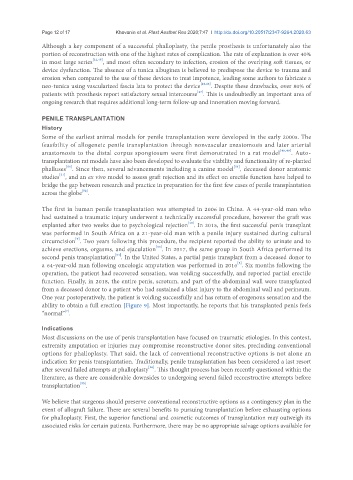Page 541 - Read Online
P. 541
Page 12 of 17 Khavanin et al. Plast Aesthet Res 2020;7:47 I http://dx.doi.org/10.20517/2347-9264.2020.63
Although a key component of a successful phalloplasty, the penile prosthesis is unfortunately also the
portion of reconstruction with one of the highest rates of complication. The rate of explanation is over 40%
in most large series [22,45] , and most often secondary to infection, erosion of the overlying soft tissues, or
device dysfunction. The absence of a tunica albuginea is believed to predispose the device to trauma and
erosion when compared to the use of these devices to treat impotence, leading some authors to fabricate a
neo-tunica using vascularized fascia lata to protect the device [28,46] . Despite these drawbacks, over 80% of
[47]
patients with prosthesis report satisfactory sexual intercourse . This is undoubtedly an important area of
ongoing research that requires additional long-term follow-up and innovation moving forward.
PENILE TRANSPLANTATION
History
Some of the earliest animal models for penile transplantation were developed in the early 2000s. The
feasibility of allogeneic penile transplantation through nonvascular anastomosis and later arterial
anastomosis to the distal corpus spongiosum were first demonstrated in a rat model [48,49] . Auto-
transplantation rat models have also been developed to evaluate the viability and functionality of re-planted
[51]
[50]
phalluses . Since then, several advancements including a canine model , deceased donor anatomic
studies , and an ex vivo model to assess graft rejection and its effect on erectile function have helped to
[21]
bridge the gap between research and practice in preparation for the first few cases of penile transplantation
[52]
across the globe .
The first in human penile transplantation was attempted in 2006 in China. A 44-year-old man who
had sustained a traumatic injury underwent a technically successful procedure, however the graft was
explanted after two weeks due to psychological rejection . In 2015, the first successful penis transplant
[10]
was performed in South Africa on a 21-year-old man with a penile injury sustained during cultural
[9]
circumcision . Two years following this procedure, the recipient reported the ability to urinate and to
[53]
achieve erections, orgasms, and ejaculation . In 2017, the same group in South Africa performed its
second penis transplantation . In the United States, a partial penis transplant from a deceased donor to
[54]
[8]
a 64-year-old man following oncologic amputation was performed in 2016 . Six months following the
operation, the patient had recovered sensation, was voiding successfully, and reported partial erectile
function. Finally, in 2018, the entire penis, scrotum, and part of the abdominal wall were transplanted
from a deceased donor to a patient who had sustained a blast injury to the abdominal wall and perineum.
One year postoperatively, the patient is voiding successfully and has return of erogenous sensation and the
ability to obtain a full erection [Figure 9]. Most importantly, he reports that his transplanted penis feels
[7]
“normal” .
Indications
Most discussions on the use of penis transplantation have focused on traumatic etiologies. In this context,
extremity amputation or injuries may compromise reconstructive donor sites, precluding conventional
options for phalloplasty. That said, the lack of conventional reconstructive options is not alone an
indication for penis transplantation. Traditionally, penile transplantation has been considered a last resort
[16]
after several failed attempts at phalloplasty . This thought process has been recently questioned within the
literature, as there are considerable downsides to undergoing several failed reconstructive attempts before
transplantation .
[55]
We believe that surgeons should preserve conventional reconstructive options as a contingency plan in the
event of allograft failure. There are several benefits to pursuing transplantation before exhausting options
for phalloplasty. First, the superior functional and cosmetic outcomes of transplantation may outweigh its
associated risks for certain patients. Furthermore, there may be no appropriate salvage options available for

